POL (1998-2000)
© GRANULAR≈SYNTHESIS (Kurt Hentschläger & Ulf Langheinrich)
Featuring Performer Diamanda Galas
Realtime Audiovisual Performance & Installation
4-channel Video (on 7 screens), 12-Channel Surround Sound
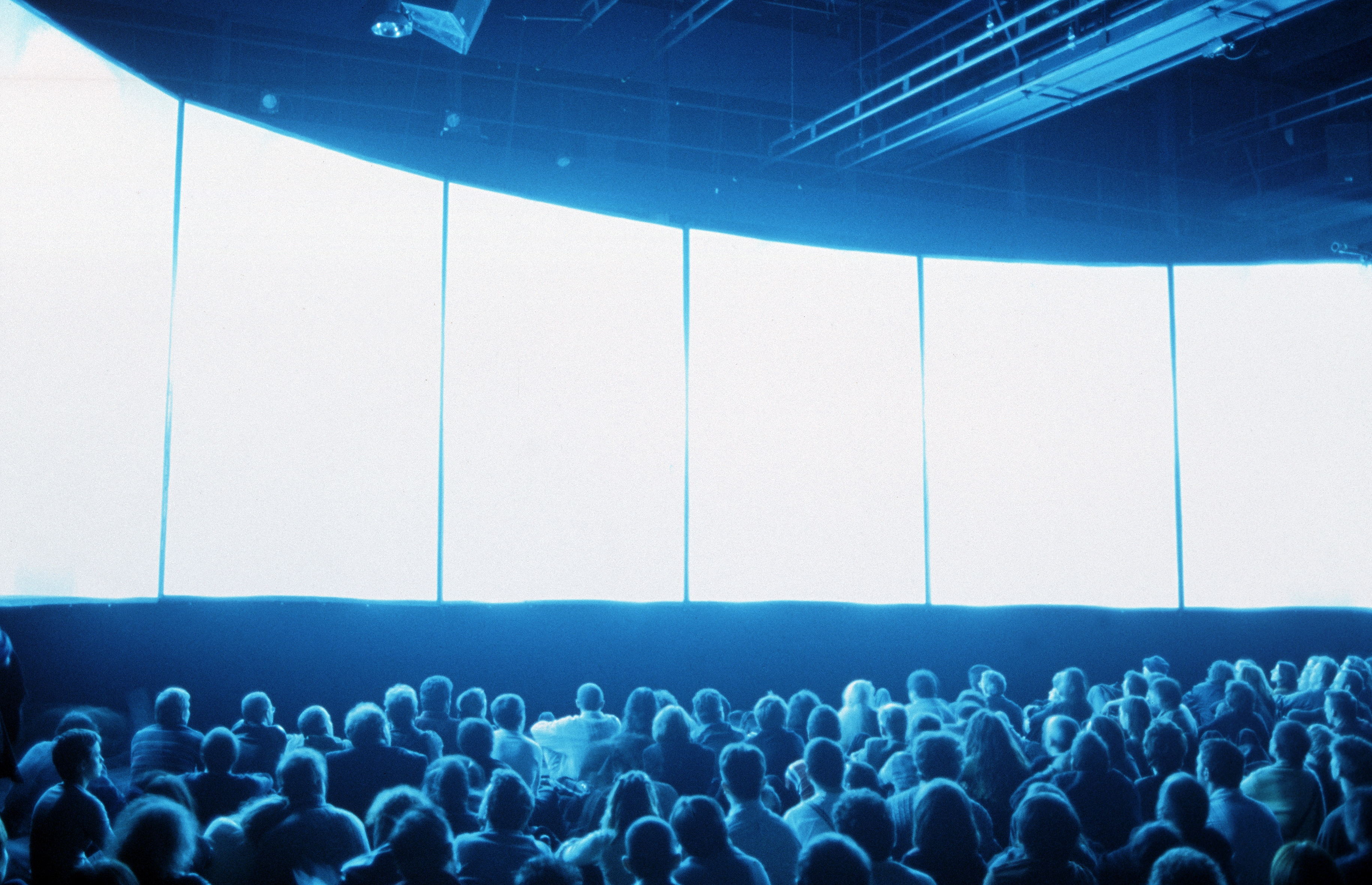
Exit Festival Creteil, Paris, 2000
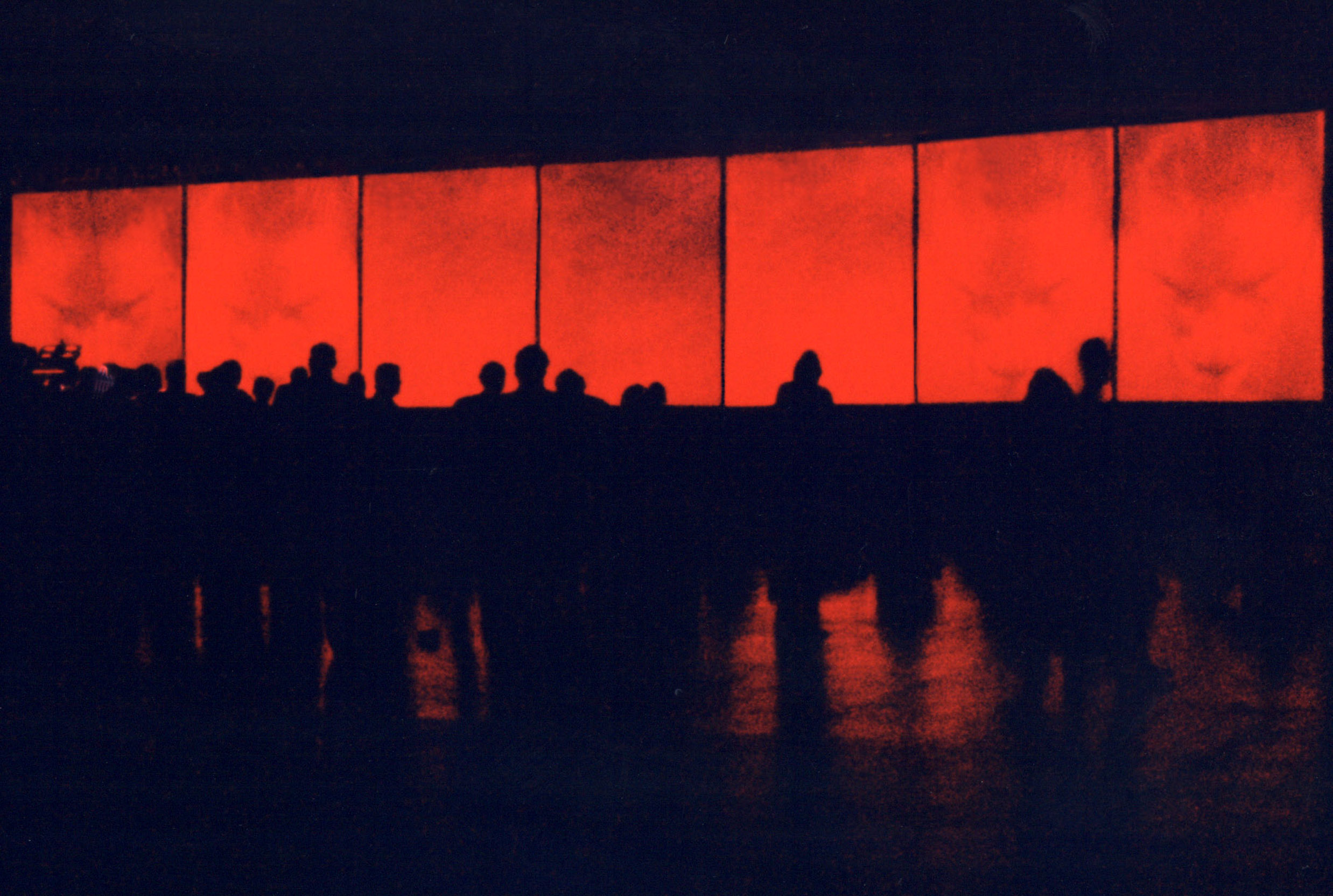
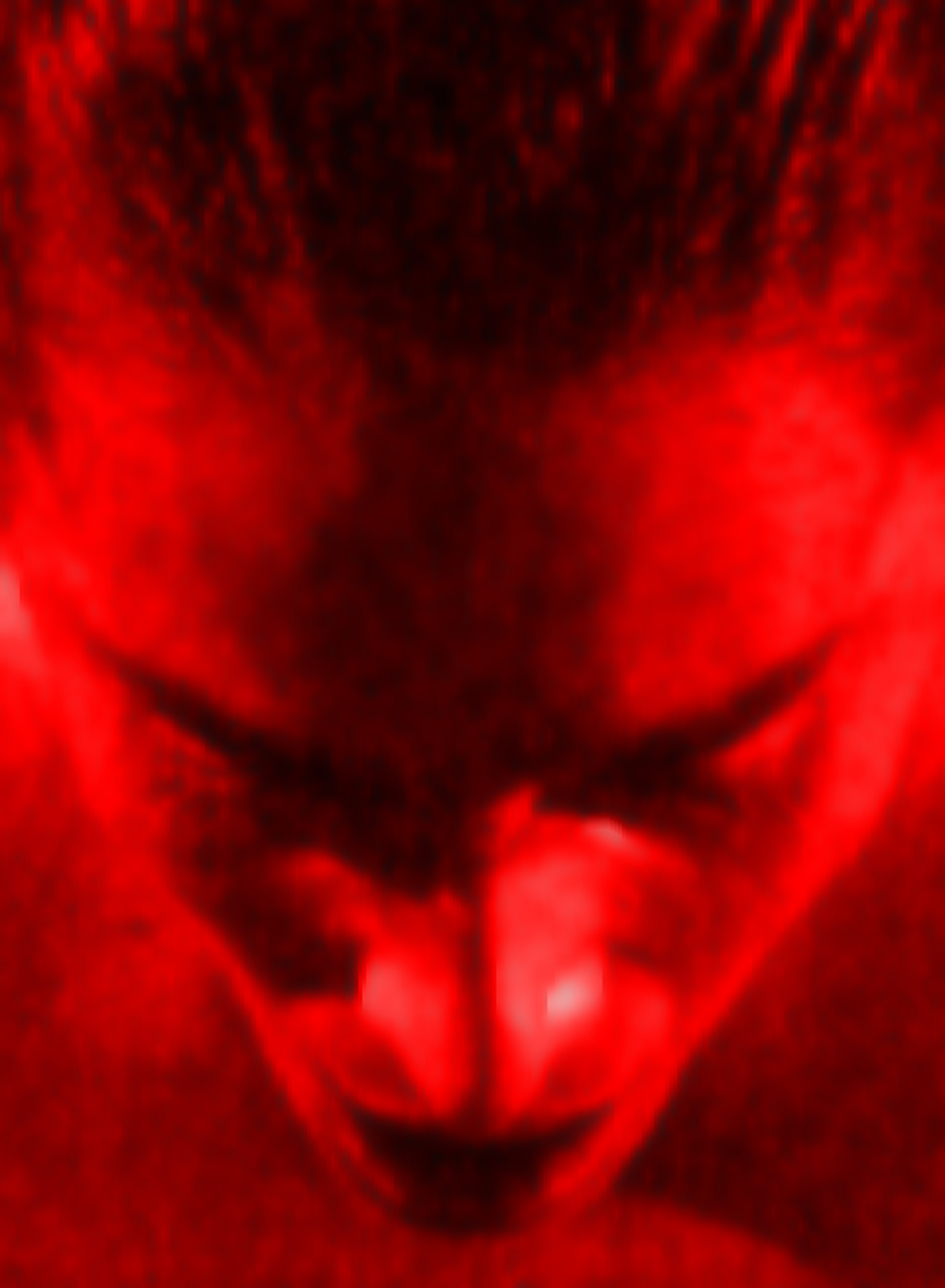
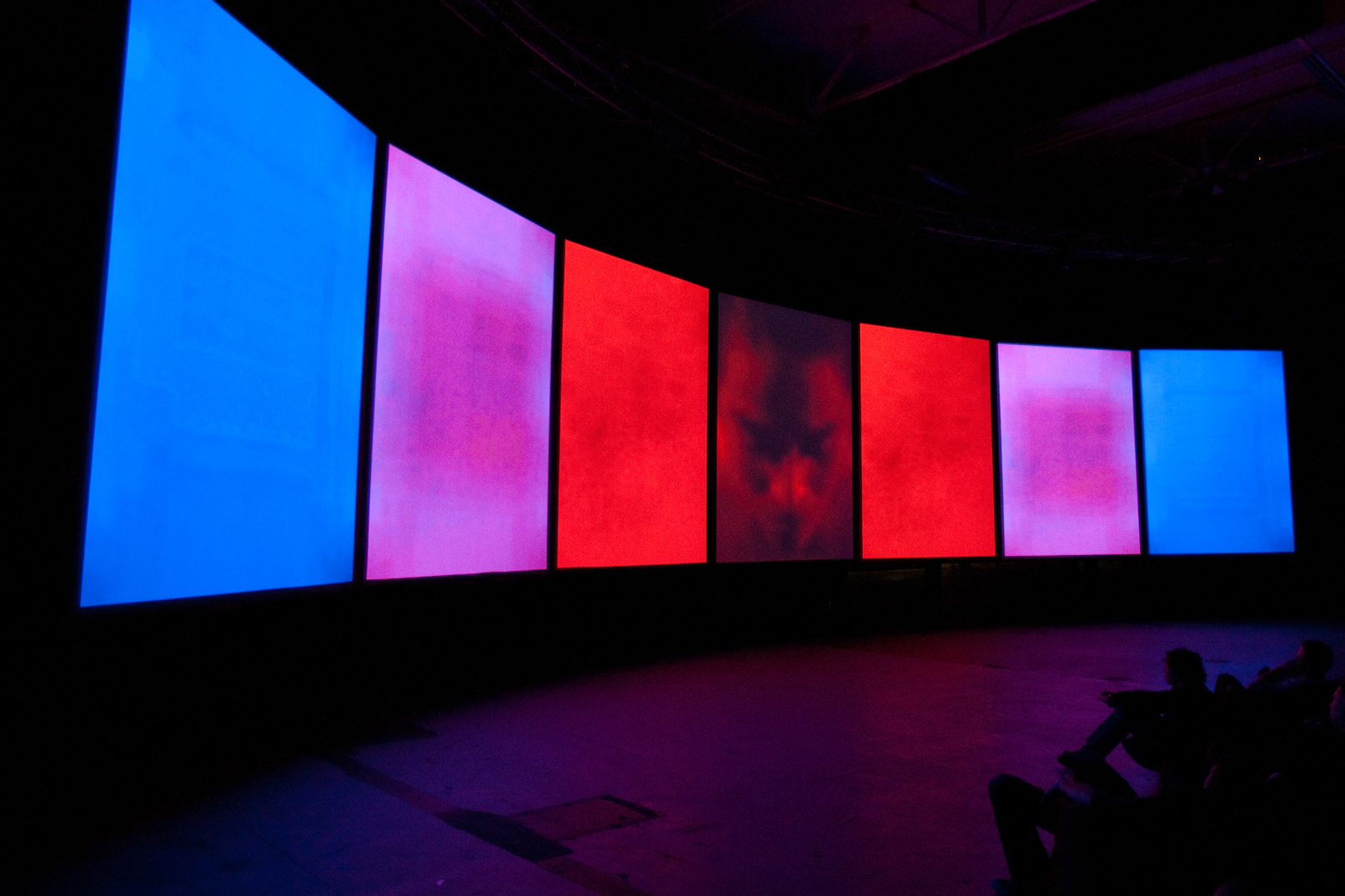
GS-Retrospective, STRP Eindhoven, 2009 - Photo: Granular~Synthesis
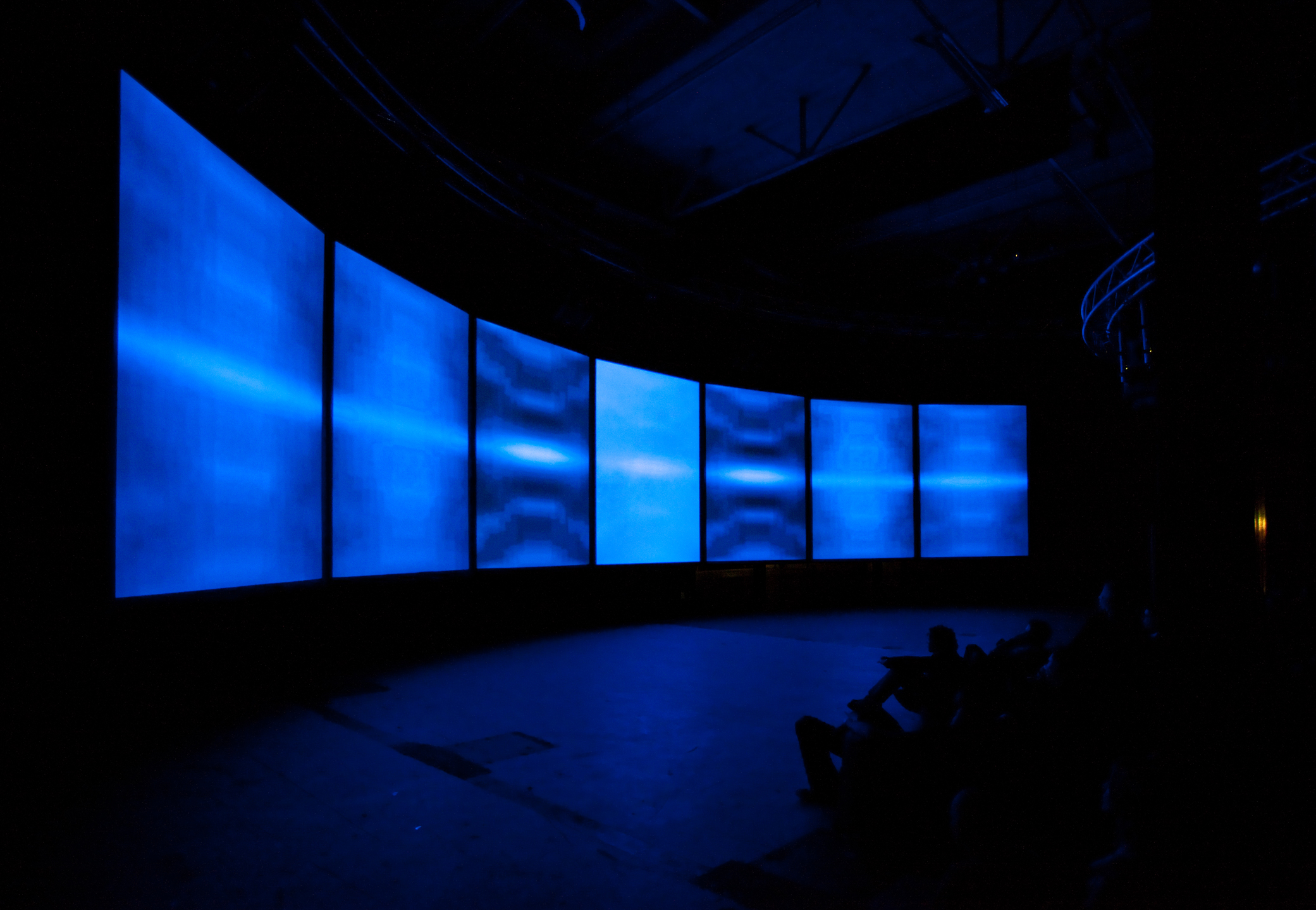
GS-Retrospective, STRP Eindhoven, 2009 - Photo: Granular~Synthesis
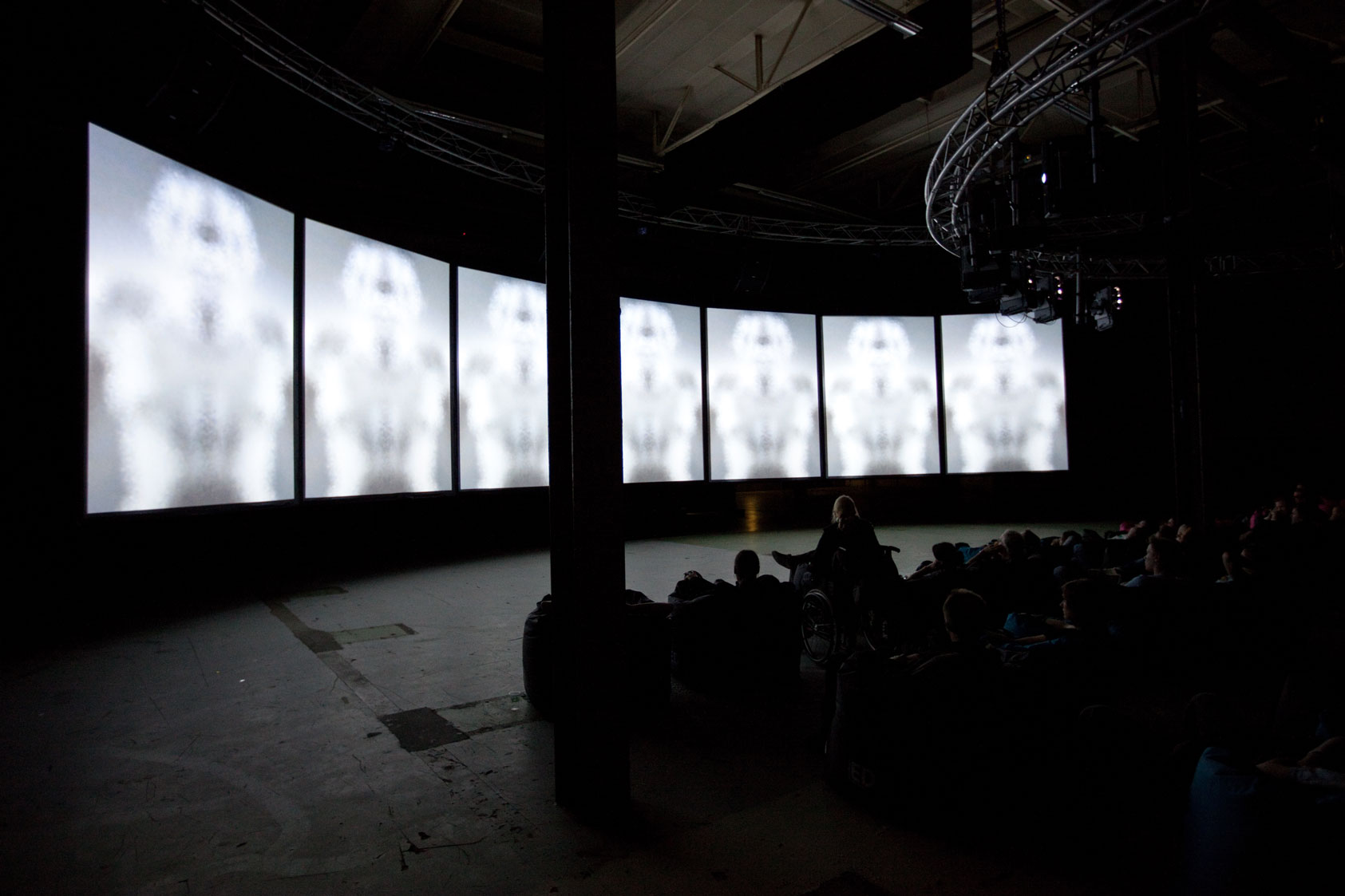
GS-Retrospective, STRP Eindhoven, 2009 - Photo: Granular~Synthesis
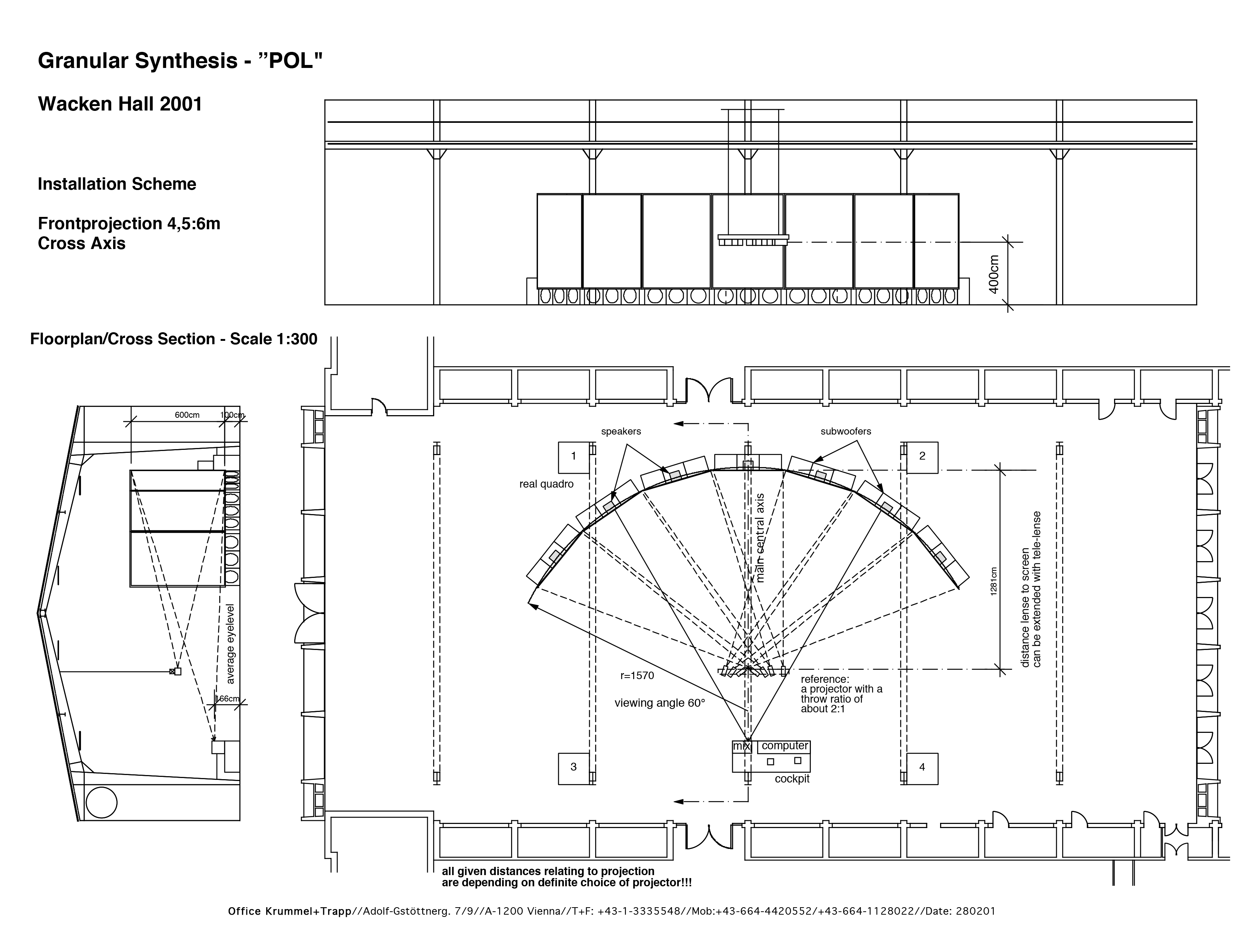
Typical POL setup: 7 portrait screens in arc shape, 8 stack audio in corners low and high, discrete voice speaker per each screen and row of subwoofer bins below screens.
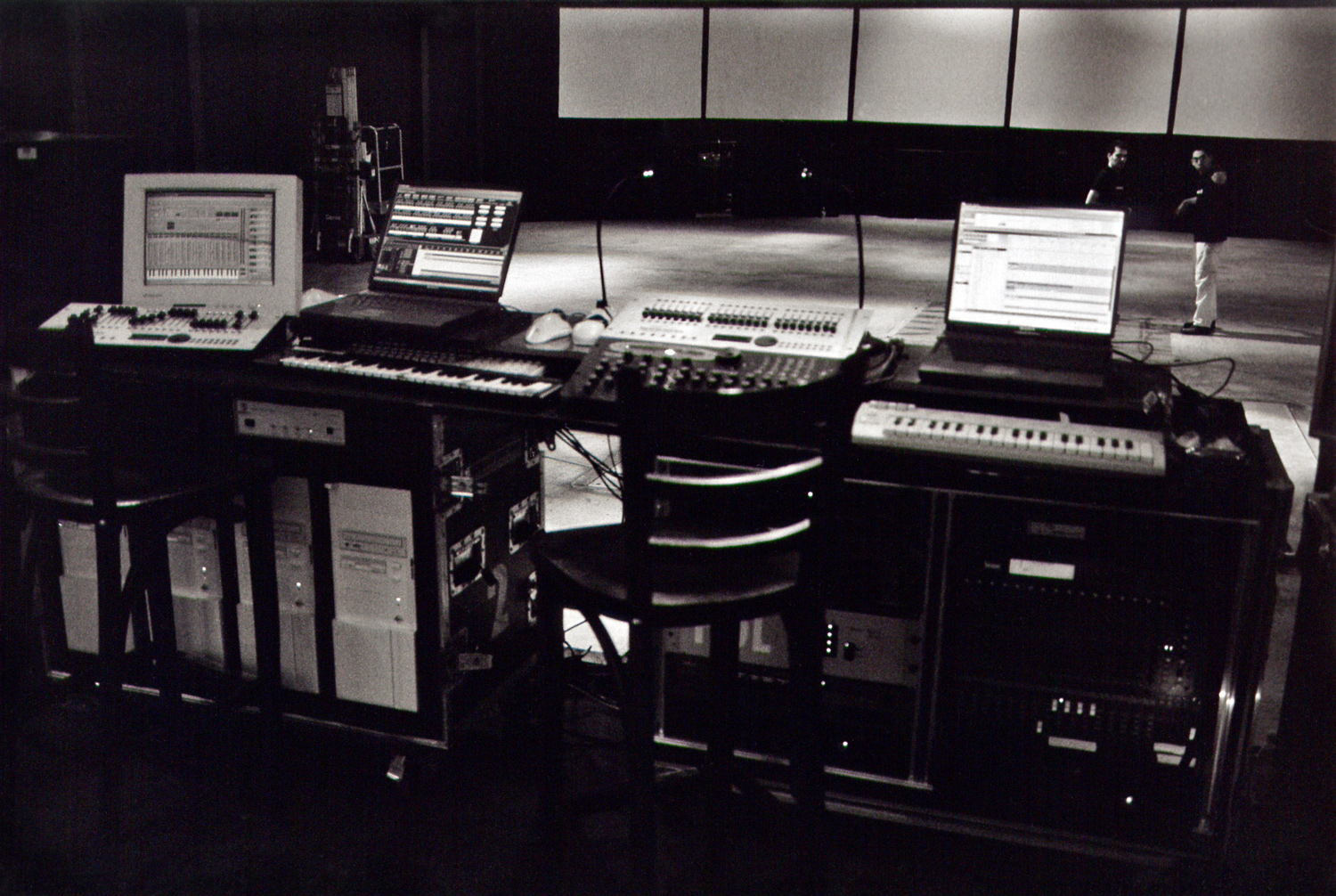
Setup @ Elektra, Montreal 1999 - Photo: Jocelyn Boulais
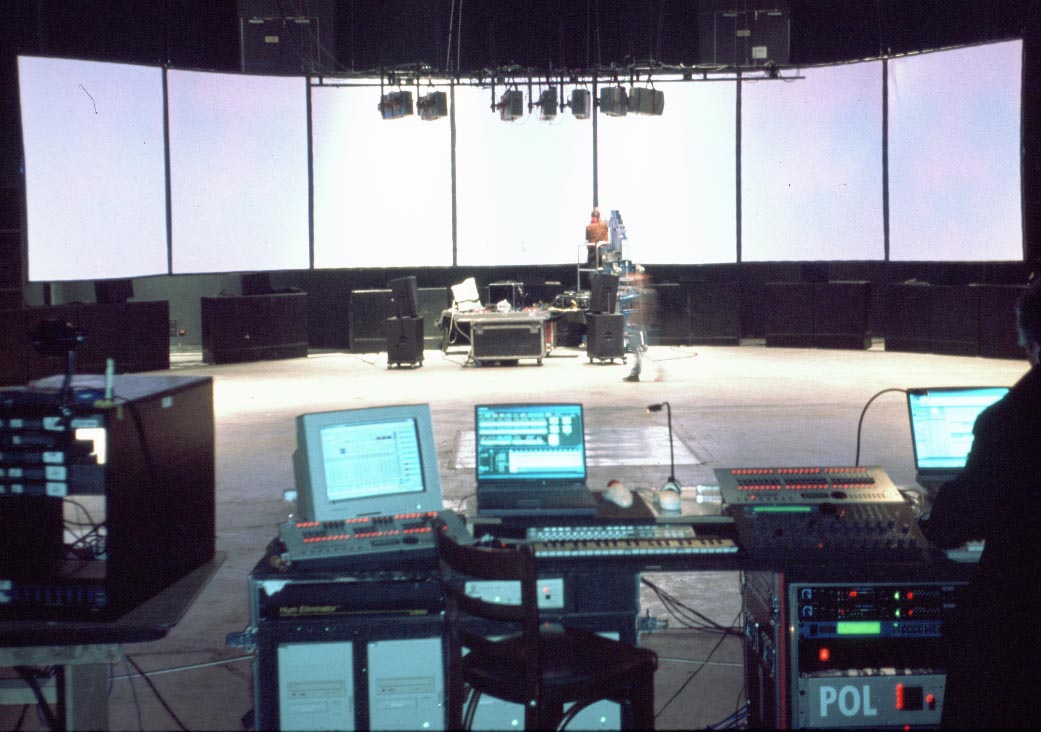
Setup @ Elektra, Montreal 1999 - Photo: Granular~Synthesis
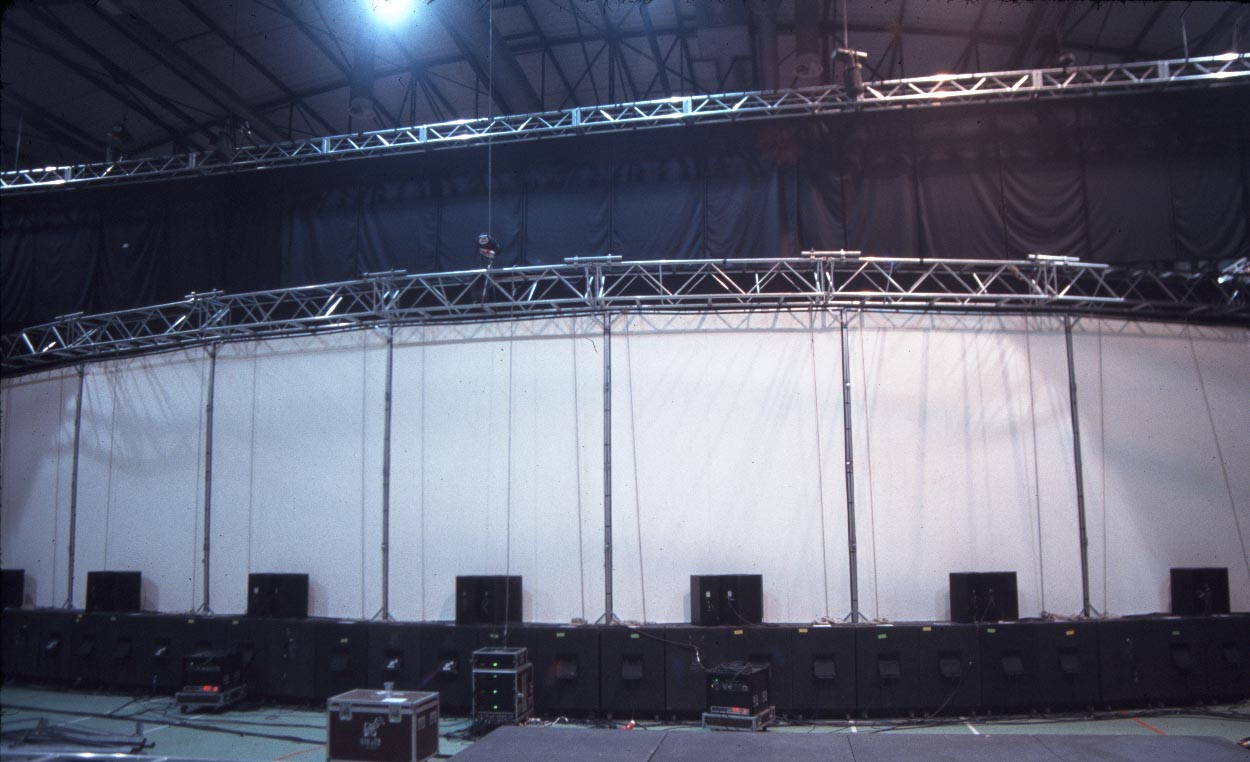
Setup POL: Behind the screens, subwoofer cabinets with "voice" speaker per screen atop of subwoofers
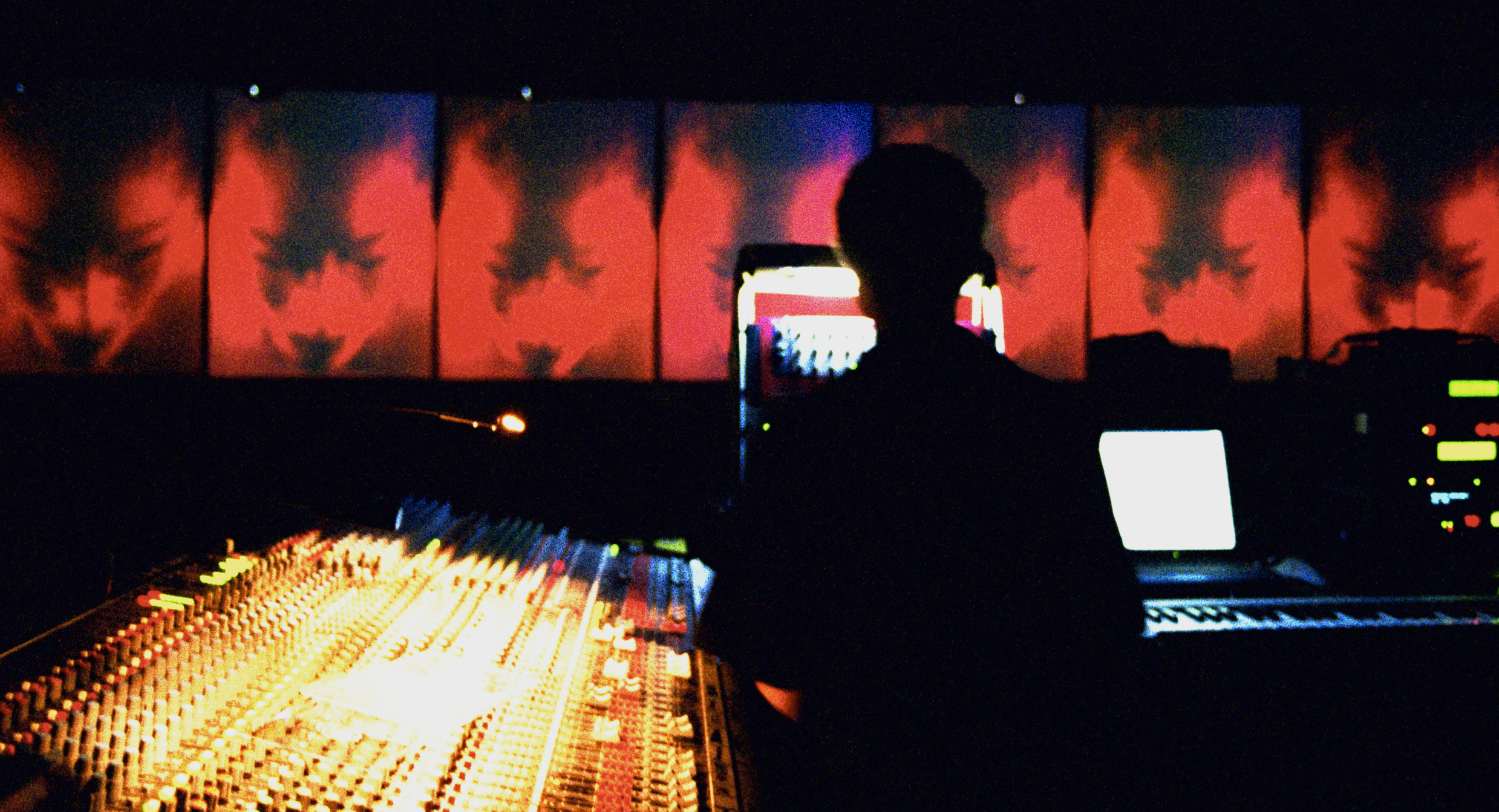
Original Voice and Performance Samples: Diamanda Galas.
POL was commissioned by Hull Time Based Arts, Hull GB and co-produced by Ars- Electronica, Linz, Austria, Maison des Arts Creteil and Manege Maubeuge, as well as Institut für Bildmedien / ZKM Karlsruhe, Germany, with support of WIEN Kultur.
Premiere version 1.0: ISEA Liverpool, 1998.
Premiere version 3.0 : Salzburger Festspiele Zeitfluss, 1999
GRANULAR~SYNTHESIS
Ars Electronica Catalogue, 1998
This written information is an attempt to edit further into the hearts and minds of future generations. The information I share will be personal and reflective. My relationship with Kurt Hentschläger and Ulf Langheinrich and to GRANULAR=SYNTHESIS has become close. Their phrase “we have a serious problem”, as the hard drive crashed a week before the premiere of MODELL 5 back in 1994 could never have been more false, since then the three of us have all experienced personal catastrophes, invariably in the middle of production.
The language they use to describe their work is formal. We share a joke between us; “Granular & Synthesis” a duo, Kurt on guitar and Ulf on bongo! They both have a disdain for acoustic music and “the expressive arts”. They are obsessed with specific technology to produce and perform the work, for example their insistence on having 30 kW of less than 40Hz sub-bass for the new performance projection POL is not formalist or macho, but it is necessary because they know what this sound technology can do: The objective of this volume is not merely to be loud, but because specific tones, pitches and shifts trigger physiological effects on the body and subsequently evoke deep psychological resonance. Despite being hard, loud, technological art work, the work of GRANULAR=SYNTHESIS is effectually some of the most “human” contemporary art.
Their attention to formal detail, working with single frame or within the single frame in long sequences of audio and video is an acute process which leads to maximum effect. The audience are subjected to a heavy onslaught of stimuli; - bombarded with light, video and audio projection - attempts to intellectualise or understand give way to the sheer physicality of the work, the audience are both affronted and seduced. Fascinated, overwhelmed and suffering in that overload gives rise to that state of mind which allows a submerging into the work - attempts to rationalise or understand defeated. Letting go of self consciousness - letting go of oneself. Disturbing, frightening, seductive and erotic.
My first exposure to the work of GRANULAR= SYNTHESIS at the AVE Festival in Arnhem, Netherlands (MODELL 3) reminded me of one of my earliest childhood TV experiences watching the 1939 version of the Wizard of Oz (Fleming), I was scared by the wizard at the end of the yellow brick road. Dorothy, played by Judy Garland, learns at the end of this tale, that the wizard is, in fact, the projection of an insecure, ordinary man, I now know this was a live video projection. This maybe leads back into the motivation of why we make Art. It is also in the context of science fiction that I have always associated MODELL 5 and the Japanese face of Akemi Takeya, with one of the most resonant moments in any film for me, that in Blade Runner at night time when the air ship cruises overhead with an apparently embedded media projection hoarding of a Japanese woman's face.
Artists image ideas, manifest the conceptual and realise fiction. Artists are good at simulating what scientists work at and they make up stories that may be true and in so doing make things real. Stelarcs performance Body I Ping has always reminded me of dressing up and fetishising the body, however Stelarc has provided an early manifestation of a real working cyborg.
GRANULAR=SYNTHESIS have made real a series of virtual beings. Wanting to escape from using images of the single head they used the torso in We want God Now, X-tended Thrill and AREAL A, however the attraction of the face seems too compelling and again in POL they are working with the female face. It is implicit that the face will be re-processed and as much trace of her original expressive qualities removed. NOISEGATE was originally titled “deep sea”. The effect initially required was one of the aquarium or zoo. Virtual beings caged behind glass or screen. The need to create characters expressive and existential in existence has been drawn upon before, and yes, the effect of the slowed down and blurred “roar” in MODELL 5 does give the appearance of a moving Francis Bacon painting; this for me is the paradox.
There are these characters who are caged and their images digitally stripped naked, somehow the fetish of the pixel and the frozen electronic image of the human form is a zeitgeist for the era in which we were brought up, the seventies and eighties. Our ability to invent technologies that can see finer and finer details in time and space can only mean that humans abilities to notice difference will become more sensitive. The processes of deconstruction and analysis in the histories of video and Media Art are apparent. Digital video has taken this further with the deconstruction of each frame into the units which make the image, the pixels, GRANULAR=SYNTHESIS work is about the process of reconstruction.
They have outstripped software and in order to develop their work through live audio-visual sampling have had to devise new software.
"There was and still is nothing on the market that would fit our needs. In 1996 we sat down and started to layout an audio-visual machine that would merge our experiences from working with Non-linear video-editing systems as well as from audio-sampling. The goal was to access video and synchronised audio from such a device single framewise in real-time. The trigger and control protocol was definitely to be MIDI, as we wanted this instrument to easily fit into the rest of our set-up. It was furthermore essential to be able to load different (audio-video) samples into RAM, to switch between them and to read them out dynamically. Also we wanted the software to run on PC, as we need independent machines for each image/sound projection . Developing the software was exciting and because of our excellent software designer and programmer, Dirk Langheinrich the program does exactly what we always wanted: VARP 9 (the name of the baby) runs stable... last time we have had that feeling with ATARI. Before we accomplished our goal (by the end of 1997) Dirk and us found ourselves completely exhausted by almost 100 beta-versions, "fascinating" hard/software incompatibilities and so forth. Amazingly the software itself (naturally) represents so much of our aesthetic knowledge that a big compositional part of recent work is embedded in the software. Most rewarding was to find out about aesthetic possibilities that we knew and dreamed about but simply were out of reach to edit "by hand". Things like applying flickerframes in an adjustable frequency within a series of other frames or modulating one visual sample (series of frames) with another, or (super exciting) visual floating - timewise mirroring of movement within a series of frames."
They are very detailed in their approach to time and data. The fascination with deconstructing narratives and real time movement has much in common with the tradition of scratch video and cut-up movies. The difference being that the found-footage movie appropriates, re-processes, re-structures appropriated material, whereas GRANULAR=SYNTHESIS go to great pains to capture their own images working within very strict conditions; constructing machines (or seating modules) to hold their subjects in. In the recently recorded raw material of the female form, pre-processed the woman appears as a pinned butterfly exhaling its last disharmonic chant; a multiphonic guttural noise.
This captured material will then be re-processed and synthesised, forming new narratives; developing a specialised meshed-media art form which has impact for a large number of younger people. This cross over audience is un-reliant on academic education and their pleasure and fear has always provided me personally with that extra edge of something to personally promote their work within the context of Hull Time Based Arts programme.
What many of the HTBA artists or projects share is there ability to subvert and entertain through content or placement; the interventions, the pranks and strategies. They intervene in audience expectations, physical location or the system they operate on. What makes GRANULAR=SYNTHESIS different from other HTBA interventionist artworks is that of context, the performance projections MODELL 3, MODELL 5 and POL are interventions into different contextual environments, that of industrial space, club and disco. The scale and power of the projection tools and the physicality of the sounds and imagery created are truly spectacular. A lot of people expect and respond to the spectacular - whether the spectacle of duration, the extreme, or the grand. It is of real interest to witness many people enjoying a de-constructive art work.
The work of GRANULAR=SYNTHESIS is not directly political but it does affect change.
The possibilities offered with dial-up multi-channel TV on demand with its promise of choice and the illusion of freedom still stands little chance of competing with the new cinema. Trance inducing performed cinema, physical and visceral.
Mike Stubbs, 28.6.98
(co-edited by Gina Czarnecki)
-----------
Sculpture May 1999 Vol.18 No. 4
Liverpool
Hearing the Noise: Revolution
International Symposium on Electronic Art (ISEA98)
“One of the most painful and distressing pieces I have ever experienced was POL by Austria’s GRANULAR=SYNTHESIS, a name Kurt Hentschläger and Ulf Langheinrich have been using since 1991 for their collaborations. For this piece, which took place in the well-known Cream club, they worked with singer Diamanda Galas, who often vocalizes sounds that seem to have been produced by a machine. A flickering image of her face was projected on seven screens, and the whole room vibrated with sound, making the viewing of the piece an intense physical experience. The projected image flickered so rapidly that the viewer was never quite sure if it was the face of a man or a woman. Through deconstructing the human form and voice, the artists created a yearning for wholeness and coherence.”
"...An hour has passed. This will never end. I do not feel like moving any longer, or protesting, or looking away. I am staring, hypnotized. What if she was on the brink to ecstasy? One would say that she was smiling...I stretch out on the floor, too. Overwhelmed.
The bass sounds have stopped. The blood pounding in my veins is taking over again, Nothing but white light and silence..."
-Zoe Leoudak
----------------------------------
FASTEN YOUR SEATBELTS
In LE DEVOIR
By François TOUSSIGNANT
Granular Synthesis' lively multimedia kills and resuscitates.
ACREQ/ELEKTRA presents
POL by GRANULAR=SYNTHESIS
(Kurt Hentschläger and Ulf Langheinrich)
Usine C, 12th and 13th November 1999.
Many of us still remember the old caricatures in which Beethoven, Berlioz, Wagner, Mahler or Bartok are accused of "causing a row" or bursting eardrums. And how easy it would be now for a critic lacking true conviction to say the same of POL by GRANULAR= SYNTHESIS. More's the pity!
It's true we couldn't have tolerated much of an increase in decibel level, and that the listener, seated directly on the ground, was physically tested by both the volume and intensity of the frequencies used; that the whole of Usine C was shaking; that our eyes were almost burnt out of our sockets by the succession of images on all seven screens; but even if we take all of this into account, it is of no more than superficial significance. Because with this music which grabbed rather than seduced its audience (from Beethoven to Stockhausen) as it gathered momentum, GRANULAR=
SYNTHESIS had created a work of art.
With this multimedia experience the company set itself the ambitious goal of achieving the noble heights more commonly associated with the Romantic movement's Gesamtkunstwerk (total artwork). In two sustained waves, we are presented with a suite of music and video images that are so intense that, alongside, anything short of their imaginative force pales.
It's difficult to describe. It opens with a pinpoint on the monitors resembling 'blank' TV screens. And from this 'nothingness' which varies in tincture, like old photographic paper, from one monitor to the next, a form emerges: the body of Diamanda Galas. This is less proof of their faith in the power of repetition and more of their interest in microphotographic imaging (photographs of breathing taken at a millionth of a second which succeed one another in 'real' cinematographic time.) A dot of skin, a dot on the screen: always the same, but never identical, like an 'empty' TV screen.
At the same time, white noise pours from the loud speakers. Here again, it's always the same, and yet different. An overwhelming blast of low register sequences, on top of which phase-changes are mixed to create rhythms that are as predictable as they are random. Sometimes the screens and the loud speakers are synchronised, at others they play completely independently of each other. There too a rhythm begins to develop with the gentle pace of a Bruckner symphony.
This is followed by a very long, and decidedly more abstract "blue section". It is at this stage that the following initiation procedure comes into play. With eyes already saturated by images - or rather, intense colour - and ears almost anaesthetised by the sound (it's loud, almost dangerously so, but is never violent), the whole body becomes a receptive and perceptive organ. The music and video combine to reach us through the sense of touch, clearing a new path and imposing their new sensitivity.
In contrast to the usual bombarding of the senses that occurs at raves or discos, here there is intent. It has been thought out and has a clear direction, the unqualified assumption that is the essence of all art. POL's use of machines is totally unrelated to both their vulgar usage in American films and on the dance floor.
Resulting from Section IV of Stockhausen's Hymen - in essence a fantastic and unnatural technological outgrowth - and the static quality of certain Warhol films, Liechtenstein-like imagery (enlarging points (pixels) to such a degree that that they almost become objects in themselves) and Californian repetition (as with Adams where nothing moves and yet ....), the universe that POL proposes invents a whole new space.
The senses and sense, both physis and mens are as much as they are put together. As Eros often unites with Thanatos, there is unavoidably violence, but poetry too. The ground upon which we first set foot never wears down and has fertile compost in abundance. This is what we gain from such an achievement. Which is to say? Probably as much as we have from the fugal counterpoint.
At the glorious artistic close of this huge technological success, we remain astounded. If we don't 'understand' everything, we have gained a good grasp of it, even if only as a result of protecting ourselves enough to withstand it. There is no denying that the work is heavy, teutonic, and has close ties with Oktophonie, by their guru Stockhausen; It is equally true that the quality of some photographs (of flies or streaks) is not very good. Nevertheless outside of its undeniable effect in entertainment terms alone, POL commendably and completely takes its place within a greater historical continuum. If we only want to experience it briefly (n'freaker), why not; it is also possible - and therein lies its strength - to reflect upon it, and find it both distressing and moving all over again.
Unfortunately it is not physically accessible to all (I repeat, it is a trying experience). Every artform has its own limits, in this case the sensorial demands imposed on its audience. If it is possible to reinvent a vocabulary and tools of expression, it is not as simple to transform the capacity of hearing. Call it art, if it pleases you. Extreme art, it definitely is. Art, it surely is. Art that would be disgusted to be restricted to the intellectualism of 'creation'.
-------------------------
LIBERATION
"POL", Musical Fascism or Precursory Genius?
"POL", the performance by GRANULAR= SYNTHESIS, two Austrians who bombard the audience with visual and auditive flashes, caused strong polemic reactions at the Ars Electronica festival. Some people came out in a state close to ecstasy, others, and quite many of them, furiously left the hall before the performance was over. The only way to report on the event is to juxtapose a witness's account with what the artists say about their intentions.
-----------
A Spectator' Report
"Aching Heart, Aching Ears, Aching Head"
The hall is lit by subdued red light. Discomfort from the start. Five giant screens have been set up in a semi-circle, and there are no seats for the audience. Am I supposed to sit on the floor? On screen, a woman's head advances and retreats, the movement is disrupted by white flashes. In a high-pitched voice she cries out "ahahahahahahahah", sampled to infinity over deafening bass sounds. The nude, photographed through a red filter, opens and closes her mouth, trembling. Now she is screaming, the volume is turned up a notch until it makes the floor resound and the heart vibrate. We are trembling. My eardrums are going to explode. The girl's face is seized by spasms.
Some people in the audience stretch out on the floor, crossing their arms behind their heads. Others leave. My head is aching. I cannot stand it any longer, I put my fingers in my ears. A gigantic pneumatic drill is breaking everything up. My body is vibrating.
The lights in the hall go out. Help! What if everything collapses? My heart, my ears, my head are aching. The strobe light is at it again, even stronger, and now it is my eyes that are suffering. Images split into fractals to the rhythm of bass beats. How do they set about hurting you even more? The noise of a different drill interrupts the pneumatic drill connected with the forty surround speakers. The girl, bathed in red, shouts herself hoarse, her face is completely deformed. My nose is trembling, and so is my body, my hair ... She wrinkles her eyebrows to the rhythm, her mouth is open, she snarls - blinding lights. I cannot watch any longer.
The volume continues to be turned up, the images become ever more jerky. The girl lowers her head, she is the incarnation of suffering. Can one get used to such an explosion of sound?
An hour has passed. This will never end. I do not feel like moving any longer, or protesting, or looking away. I am staring, hypnotized. What if she was on the brink to ecstasy? One would say that she was smiling...I stretch out on the floor, too. Overwhelmed.
The bass sounds have stopped. The blood pounding in my veins is taking over again, Nothing but white light and silence. Applause.
- Annick Rivoire
-----
GRANULAR~SYNTHESIS explains:
"Put the Audience in an Extreme State"
"There are so many nice installations entirely devoid of danger which give all the power to the machines without there being any meaning behind them. Art has the potential to change your life. It is important that the audience cannot escape. This is not an 'intellectual' spectacle even if there is a major concept behind it. It is about catharsis, about arousing emotions. We had to improvise and be more violent than foreseen because certain machines were not working. We wanted to put the audience in an extreme state between joy, ecstasy and pain. POL, which refers to the magnetic poles, is like a center of energy devouring the spectator. In our dramatic concept growing pressure and respite alternate. The extreme intensity makes it possible to wipe everything out, to arrive at nothingness. A nothingness like a desert, a world of hidden richness.
We found a way of creating very loud sounds without hurting anybody: we only work with very high and very low frequencies. Any middle frequency that would actually be dangerous in due to the sound volume is suppressed. The same goes for the images: the more they oscillate, the less you want to move. It shakes you but at the same time you find it hard to move. The voice and the images are musical material. Using a single interface, we mix audio and video which enables an intuitive and progressive process (1). It is quite unusual for us to see people leave a performance before it is over, but it was the première of a work in progress. One day a friend described what we are doing as 'wildly boring'. That's pretty smart."
Recorded by Annick Rivoire
(1) The GRANULAR SYNTHESIS invention is based on the principle of synthesizing sound by means of computers. Very short sound particles, so-called grains of sound, are sampled, duplicated, mixed and then arranged in time. GRANULAR SYNTHESIS apply this technique to videos. The pieces of voice recordings, images and sounds are sampled live to produce "visual music".
Caption:
The GRANULAR SYNTHESIS performance put spectators on the brink of the unbearable, a state the artists took responsibility for.
POL was commissioned by Hull Time Based Arts, Hull GB and co-produced by Ars- Electronica, Linz, Austria, Maison des Arts Creteil and Manege Maubeuge, as well as Institut für Bildmedien / ZKM Karlsruhe, Germany, with support of WIEN Kultur.
Premiere version 1.0: ISEA Liverpool, 1998.
Premiere version 3.0 : Salzburger Festspiele Zeitfluss, 1999
GRANULAR~SYNTHESIS
Ars Electronica Catalogue, 1998
This written information is an attempt to edit further into the hearts and minds of future generations. The information I share will be personal and reflective. My relationship with Kurt Hentschläger and Ulf Langheinrich and to GRANULAR=SYNTHESIS has become close. Their phrase “we have a serious problem”, as the hard drive crashed a week before the premiere of MODELL 5 back in 1994 could never have been more false, since then the three of us have all experienced personal catastrophes, invariably in the middle of production.
The language they use to describe their work is formal. We share a joke between us; “Granular & Synthesis” a duo, Kurt on guitar and Ulf on bongo! They both have a disdain for acoustic music and “the expressive arts”. They are obsessed with specific technology to produce and perform the work, for example their insistence on having 30 kW of less than 40Hz sub-bass for the new performance projection POL is not formalist or macho, but it is necessary because they know what this sound technology can do: The objective of this volume is not merely to be loud, but because specific tones, pitches and shifts trigger physiological effects on the body and subsequently evoke deep psychological resonance. Despite being hard, loud, technological art work, the work of GRANULAR=SYNTHESIS is effectually some of the most “human” contemporary art.
Their attention to formal detail, working with single frame or within the single frame in long sequences of audio and video is an acute process which leads to maximum effect. The audience are subjected to a heavy onslaught of stimuli; - bombarded with light, video and audio projection - attempts to intellectualise or understand give way to the sheer physicality of the work, the audience are both affronted and seduced. Fascinated, overwhelmed and suffering in that overload gives rise to that state of mind which allows a submerging into the work - attempts to rationalise or understand defeated. Letting go of self consciousness - letting go of oneself. Disturbing, frightening, seductive and erotic.
My first exposure to the work of GRANULAR= SYNTHESIS at the AVE Festival in Arnhem, Netherlands (MODELL 3) reminded me of one of my earliest childhood TV experiences watching the 1939 version of the Wizard of Oz (Fleming), I was scared by the wizard at the end of the yellow brick road. Dorothy, played by Judy Garland, learns at the end of this tale, that the wizard is, in fact, the projection of an insecure, ordinary man, I now know this was a live video projection. This maybe leads back into the motivation of why we make Art. It is also in the context of science fiction that I have always associated MODELL 5 and the Japanese face of Akemi Takeya, with one of the most resonant moments in any film for me, that in Blade Runner at night time when the air ship cruises overhead with an apparently embedded media projection hoarding of a Japanese woman's face.
Artists image ideas, manifest the conceptual and realise fiction. Artists are good at simulating what scientists work at and they make up stories that may be true and in so doing make things real. Stelarcs performance Body I Ping has always reminded me of dressing up and fetishising the body, however Stelarc has provided an early manifestation of a real working cyborg.
GRANULAR=SYNTHESIS have made real a series of virtual beings. Wanting to escape from using images of the single head they used the torso in We want God Now, X-tended Thrill and AREAL A, however the attraction of the face seems too compelling and again in POL they are working with the female face. It is implicit that the face will be re-processed and as much trace of her original expressive qualities removed. NOISEGATE was originally titled “deep sea”. The effect initially required was one of the aquarium or zoo. Virtual beings caged behind glass or screen. The need to create characters expressive and existential in existence has been drawn upon before, and yes, the effect of the slowed down and blurred “roar” in MODELL 5 does give the appearance of a moving Francis Bacon painting; this for me is the paradox.
There are these characters who are caged and their images digitally stripped naked, somehow the fetish of the pixel and the frozen electronic image of the human form is a zeitgeist for the era in which we were brought up, the seventies and eighties. Our ability to invent technologies that can see finer and finer details in time and space can only mean that humans abilities to notice difference will become more sensitive. The processes of deconstruction and analysis in the histories of video and Media Art are apparent. Digital video has taken this further with the deconstruction of each frame into the units which make the image, the pixels, GRANULAR=SYNTHESIS work is about the process of reconstruction.
They have outstripped software and in order to develop their work through live audio-visual sampling have had to devise new software.
"There was and still is nothing on the market that would fit our needs. In 1996 we sat down and started to layout an audio-visual machine that would merge our experiences from working with Non-linear video-editing systems as well as from audio-sampling. The goal was to access video and synchronised audio from such a device single framewise in real-time. The trigger and control protocol was definitely to be MIDI, as we wanted this instrument to easily fit into the rest of our set-up. It was furthermore essential to be able to load different (audio-video) samples into RAM, to switch between them and to read them out dynamically. Also we wanted the software to run on PC, as we need independent machines for each image/sound projection . Developing the software was exciting and because of our excellent software designer and programmer, Dirk Langheinrich the program does exactly what we always wanted: VARP 9 (the name of the baby) runs stable... last time we have had that feeling with ATARI. Before we accomplished our goal (by the end of 1997) Dirk and us found ourselves completely exhausted by almost 100 beta-versions, "fascinating" hard/software incompatibilities and so forth. Amazingly the software itself (naturally) represents so much of our aesthetic knowledge that a big compositional part of recent work is embedded in the software. Most rewarding was to find out about aesthetic possibilities that we knew and dreamed about but simply were out of reach to edit "by hand". Things like applying flickerframes in an adjustable frequency within a series of other frames or modulating one visual sample (series of frames) with another, or (super exciting) visual floating - timewise mirroring of movement within a series of frames."
They are very detailed in their approach to time and data. The fascination with deconstructing narratives and real time movement has much in common with the tradition of scratch video and cut-up movies. The difference being that the found-footage movie appropriates, re-processes, re-structures appropriated material, whereas GRANULAR=SYNTHESIS go to great pains to capture their own images working within very strict conditions; constructing machines (or seating modules) to hold their subjects in. In the recently recorded raw material of the female form, pre-processed the woman appears as a pinned butterfly exhaling its last disharmonic chant; a multiphonic guttural noise.
This captured material will then be re-processed and synthesised, forming new narratives; developing a specialised meshed-media art form which has impact for a large number of younger people. This cross over audience is un-reliant on academic education and their pleasure and fear has always provided me personally with that extra edge of something to personally promote their work within the context of Hull Time Based Arts programme.
What many of the HTBA artists or projects share is there ability to subvert and entertain through content or placement; the interventions, the pranks and strategies. They intervene in audience expectations, physical location or the system they operate on. What makes GRANULAR=SYNTHESIS different from other HTBA interventionist artworks is that of context, the performance projections MODELL 3, MODELL 5 and POL are interventions into different contextual environments, that of industrial space, club and disco. The scale and power of the projection tools and the physicality of the sounds and imagery created are truly spectacular. A lot of people expect and respond to the spectacular - whether the spectacle of duration, the extreme, or the grand. It is of real interest to witness many people enjoying a de-constructive art work.
The work of GRANULAR=SYNTHESIS is not directly political but it does affect change.
The possibilities offered with dial-up multi-channel TV on demand with its promise of choice and the illusion of freedom still stands little chance of competing with the new cinema. Trance inducing performed cinema, physical and visceral.
Mike Stubbs, 28.6.98
(co-edited by Gina Czarnecki)
-----------
Sculpture May 1999 Vol.18 No. 4
Liverpool
Hearing the Noise: Revolution
International Symposium on Electronic Art (ISEA98)
“One of the most painful and distressing pieces I have ever experienced was POL by Austria’s GRANULAR=SYNTHESIS, a name Kurt Hentschläger and Ulf Langheinrich have been using since 1991 for their collaborations. For this piece, which took place in the well-known Cream club, they worked with singer Diamanda Galas, who often vocalizes sounds that seem to have been produced by a machine. A flickering image of her face was projected on seven screens, and the whole room vibrated with sound, making the viewing of the piece an intense physical experience. The projected image flickered so rapidly that the viewer was never quite sure if it was the face of a man or a woman. Through deconstructing the human form and voice, the artists created a yearning for wholeness and coherence.”
"...An hour has passed. This will never end. I do not feel like moving any longer, or protesting, or looking away. I am staring, hypnotized. What if she was on the brink to ecstasy? One would say that she was smiling...I stretch out on the floor, too. Overwhelmed.
The bass sounds have stopped. The blood pounding in my veins is taking over again, Nothing but white light and silence..."
-Zoe Leoudak
----------------------------------
FASTEN YOUR SEATBELTS
In LE DEVOIR
By François TOUSSIGNANT
Granular Synthesis' lively multimedia kills and resuscitates.
ACREQ/ELEKTRA presents
POL by GRANULAR=SYNTHESIS
(Kurt Hentschläger and Ulf Langheinrich)
Usine C, 12th and 13th November 1999.
Many of us still remember the old caricatures in which Beethoven, Berlioz, Wagner, Mahler or Bartok are accused of "causing a row" or bursting eardrums. And how easy it would be now for a critic lacking true conviction to say the same of POL by GRANULAR= SYNTHESIS. More's the pity!
It's true we couldn't have tolerated much of an increase in decibel level, and that the listener, seated directly on the ground, was physically tested by both the volume and intensity of the frequencies used; that the whole of Usine C was shaking; that our eyes were almost burnt out of our sockets by the succession of images on all seven screens; but even if we take all of this into account, it is of no more than superficial significance. Because with this music which grabbed rather than seduced its audience (from Beethoven to Stockhausen) as it gathered momentum, GRANULAR=
SYNTHESIS had created a work of art.
With this multimedia experience the company set itself the ambitious goal of achieving the noble heights more commonly associated with the Romantic movement's Gesamtkunstwerk (total artwork). In two sustained waves, we are presented with a suite of music and video images that are so intense that, alongside, anything short of their imaginative force pales.
It's difficult to describe. It opens with a pinpoint on the monitors resembling 'blank' TV screens. And from this 'nothingness' which varies in tincture, like old photographic paper, from one monitor to the next, a form emerges: the body of Diamanda Galas. This is less proof of their faith in the power of repetition and more of their interest in microphotographic imaging (photographs of breathing taken at a millionth of a second which succeed one another in 'real' cinematographic time.) A dot of skin, a dot on the screen: always the same, but never identical, like an 'empty' TV screen.
At the same time, white noise pours from the loud speakers. Here again, it's always the same, and yet different. An overwhelming blast of low register sequences, on top of which phase-changes are mixed to create rhythms that are as predictable as they are random. Sometimes the screens and the loud speakers are synchronised, at others they play completely independently of each other. There too a rhythm begins to develop with the gentle pace of a Bruckner symphony.
This is followed by a very long, and decidedly more abstract "blue section". It is at this stage that the following initiation procedure comes into play. With eyes already saturated by images - or rather, intense colour - and ears almost anaesthetised by the sound (it's loud, almost dangerously so, but is never violent), the whole body becomes a receptive and perceptive organ. The music and video combine to reach us through the sense of touch, clearing a new path and imposing their new sensitivity.
In contrast to the usual bombarding of the senses that occurs at raves or discos, here there is intent. It has been thought out and has a clear direction, the unqualified assumption that is the essence of all art. POL's use of machines is totally unrelated to both their vulgar usage in American films and on the dance floor.
Resulting from Section IV of Stockhausen's Hymen - in essence a fantastic and unnatural technological outgrowth - and the static quality of certain Warhol films, Liechtenstein-like imagery (enlarging points (pixels) to such a degree that that they almost become objects in themselves) and Californian repetition (as with Adams where nothing moves and yet ....), the universe that POL proposes invents a whole new space.
The senses and sense, both physis and mens are as much as they are put together. As Eros often unites with Thanatos, there is unavoidably violence, but poetry too. The ground upon which we first set foot never wears down and has fertile compost in abundance. This is what we gain from such an achievement. Which is to say? Probably as much as we have from the fugal counterpoint.
At the glorious artistic close of this huge technological success, we remain astounded. If we don't 'understand' everything, we have gained a good grasp of it, even if only as a result of protecting ourselves enough to withstand it. There is no denying that the work is heavy, teutonic, and has close ties with Oktophonie, by their guru Stockhausen; It is equally true that the quality of some photographs (of flies or streaks) is not very good. Nevertheless outside of its undeniable effect in entertainment terms alone, POL commendably and completely takes its place within a greater historical continuum. If we only want to experience it briefly (n'freaker), why not; it is also possible - and therein lies its strength - to reflect upon it, and find it both distressing and moving all over again.
Unfortunately it is not physically accessible to all (I repeat, it is a trying experience). Every artform has its own limits, in this case the sensorial demands imposed on its audience. If it is possible to reinvent a vocabulary and tools of expression, it is not as simple to transform the capacity of hearing. Call it art, if it pleases you. Extreme art, it definitely is. Art, it surely is. Art that would be disgusted to be restricted to the intellectualism of 'creation'.
-------------------------
LIBERATION
"POL", Musical Fascism or Precursory Genius?
"POL", the performance by GRANULAR= SYNTHESIS, two Austrians who bombard the audience with visual and auditive flashes, caused strong polemic reactions at the Ars Electronica festival. Some people came out in a state close to ecstasy, others, and quite many of them, furiously left the hall before the performance was over. The only way to report on the event is to juxtapose a witness's account with what the artists say about their intentions.
-----------
A Spectator' Report
"Aching Heart, Aching Ears, Aching Head"
The hall is lit by subdued red light. Discomfort from the start. Five giant screens have been set up in a semi-circle, and there are no seats for the audience. Am I supposed to sit on the floor? On screen, a woman's head advances and retreats, the movement is disrupted by white flashes. In a high-pitched voice she cries out "ahahahahahahahah", sampled to infinity over deafening bass sounds. The nude, photographed through a red filter, opens and closes her mouth, trembling. Now she is screaming, the volume is turned up a notch until it makes the floor resound and the heart vibrate. We are trembling. My eardrums are going to explode. The girl's face is seized by spasms.
Some people in the audience stretch out on the floor, crossing their arms behind their heads. Others leave. My head is aching. I cannot stand it any longer, I put my fingers in my ears. A gigantic pneumatic drill is breaking everything up. My body is vibrating.
The lights in the hall go out. Help! What if everything collapses? My heart, my ears, my head are aching. The strobe light is at it again, even stronger, and now it is my eyes that are suffering. Images split into fractals to the rhythm of bass beats. How do they set about hurting you even more? The noise of a different drill interrupts the pneumatic drill connected with the forty surround speakers. The girl, bathed in red, shouts herself hoarse, her face is completely deformed. My nose is trembling, and so is my body, my hair ... She wrinkles her eyebrows to the rhythm, her mouth is open, she snarls - blinding lights. I cannot watch any longer.
The volume continues to be turned up, the images become ever more jerky. The girl lowers her head, she is the incarnation of suffering. Can one get used to such an explosion of sound?
An hour has passed. This will never end. I do not feel like moving any longer, or protesting, or looking away. I am staring, hypnotized. What if she was on the brink to ecstasy? One would say that she was smiling...I stretch out on the floor, too. Overwhelmed.
The bass sounds have stopped. The blood pounding in my veins is taking over again, Nothing but white light and silence. Applause.
- Annick Rivoire
-----
GRANULAR~SYNTHESIS explains:
"Put the Audience in an Extreme State"
"There are so many nice installations entirely devoid of danger which give all the power to the machines without there being any meaning behind them. Art has the potential to change your life. It is important that the audience cannot escape. This is not an 'intellectual' spectacle even if there is a major concept behind it. It is about catharsis, about arousing emotions. We had to improvise and be more violent than foreseen because certain machines were not working. We wanted to put the audience in an extreme state between joy, ecstasy and pain. POL, which refers to the magnetic poles, is like a center of energy devouring the spectator. In our dramatic concept growing pressure and respite alternate. The extreme intensity makes it possible to wipe everything out, to arrive at nothingness. A nothingness like a desert, a world of hidden richness.
We found a way of creating very loud sounds without hurting anybody: we only work with very high and very low frequencies. Any middle frequency that would actually be dangerous in due to the sound volume is suppressed. The same goes for the images: the more they oscillate, the less you want to move. It shakes you but at the same time you find it hard to move. The voice and the images are musical material. Using a single interface, we mix audio and video which enables an intuitive and progressive process (1). It is quite unusual for us to see people leave a performance before it is over, but it was the première of a work in progress. One day a friend described what we are doing as 'wildly boring'. That's pretty smart."
Recorded by Annick Rivoire
(1) The GRANULAR SYNTHESIS invention is based on the principle of synthesizing sound by means of computers. Very short sound particles, so-called grains of sound, are sampled, duplicated, mixed and then arranged in time. GRANULAR SYNTHESIS apply this technique to videos. The pieces of voice recordings, images and sounds are sampled live to produce "visual music".
Caption:
The GRANULAR SYNTHESIS performance put spectators on the brink of the unbearable, a state the artists took responsibility for.